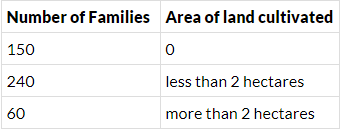Worksheet Solution: The Story of Palampur Class 9 Worksheet Economics
Multiple Choice Questions
Q1: Which of the following terms is used for measuring the crop produced on a given piece of land during a single year?
(a) Yield
(b) Productivity
(c) Cultivation
(d) Output
Ans: (a)
Q2: What is done to surplus wheat in Palampur?
(a) Sold in the market
(b) Destroyed
(c) Given in charity
(d) Stocked by self
Ans: (a)
Q3: HYV seeds stands for
(a) Heavy yielding variety seeds
(b) High yielding variety seeds
(c) Half yielding variety seeds
(d) None of the above
Ans: (b)
Q4: Which of the following statements is not true about small-scale manufacturing in villages?
(a) Farmers engage in it to supplement their income
(b) Farmers take help of their family members
(c) The production is done mostly at home
(d) Farmers produce articles for their own use
Ans: (d)
Q5: Which is the most abundant factor of production in India?
(a) Land
(b) Capital
(c) Labour
(d) Tools and machines
Ans: (c)
Q6: ‘Operation Flood’ is related to :
(a) Control flood
(b) Produce fish
(c) Milk production
(d) Grain production
Ans: (c)
Q7: Which Kharif crop is used for cattle feed?
(a) Sugarcane
(b) Potato
(c) Jowar and bajra
(d) Wheat
Ans: (c)
Q8: Where do most of the small farmers borrow money to arrange for the capital in Palampur?
(a) Banks
(b) Co-operative Societies
(c) Village money lenders
(d) Friends and relatives
Ans: (c)
Q9: Which one of the following is a rabi crop?
(a) Cotton
(b) Millets
(c) Gram
(d) Rice
Ans: (c)
Q10: Scope of farming activity is limited in Palampur due to
(a) fixed amount of land
(b) lack of irrigation
(c) lack of labour
(d) none of the above
Ans: (a)
Very Short Answer Questions
Q1: What are the examples of working capital?
Ans: Raw materials and money in hand are called working capital.
Q2: Give an example of fixed physical capital.
Ans: Farmer’s plough
Q3: Name the third crop grown in Palampur as a part of multiple cropping.
Ans: Potato
Q4: Which factor of production is fixed and scarce?
Ans: Land is fixed and scarce.
Q5: During which season do farmers of Palampur grow jowar and bajra?
Ans: During the rainy season (kharif) farmers grow jowar and bajra.
Q6: What is the standard unit of measuring land?
Ans: The standard unit of measuring land is hectare.
Q7: Modern farming methods require the farmer to start with more cash than before. Why?
Ans: Modern farming methods require the use of HYV seeds which needs chemical fertilizers and pesticides to procure best result and increased production. In order to buy all these inputs a lot of money is needed. Thus, farmer needs to have more cash to start farming.
Q8: Mention any two characteristics of modern farming.
Ans: Two characteristics of modern farming:
(i) Use of HYV seeds
(ii) Use of chemical fertilizers and pesticides
Q9: What is meant by non-farm activities? Explain with examples.
Ans: In villages across India, farming is the main production activity. The other production activities, referred to as non-farm activities include small manufacturing, transport, shop-keeping, etc.
Q10: Why are farm labourers like Dala and Ramkali poor?
Ans: Farm labourers like Dala and Ramkali are poor because they are landless and due to heavy competition for work among the farm labourers they are paid low wages.
Short Answer Questions
Q1: What is the working capital required by the farmer using modern farming methods?
Ans: The working capital required by the farmer using modern farming methods are raw material and money. Some money is always required during production to make payments and buy other necessary items.
Q2: Why are the wages for farm labourers less than minimum wages?
Ans: There are many landless farm labourers who work on daily wages in Palampur. The minimum wages for a farm labourer set by the government is Rs 115 (April, 2011) per day. There is heavy competition for work among the farm labourers in Palampur, so people agree to work for lower wages.
Q3: What are the non-farm production activities taking place in your region? Make a short list.
Ans: The non-farm production activities taking place in our region are:
(i) Dairy
(ii) Transportation
(iii) General stores
(iv) Fishing
Q4: Why do so many families of farmers cultivate such small plots of land?
Ans: Existing land is divided among family members continuously and as a result each member of the family gets smaller plot of the land. Since land is fixed and there is no scope of bringing new land under cultivation, farmers are forced to cultivate small plots of land.
Q5: Construct a table on the distribution of land among the 450 families of Palampur.
Ans:

|
55 videos|525 docs|78 tests
|
FAQs on Worksheet Solution: The Story of Palampur Class 9 Worksheet Economics
| 1. What is the story of Palampur? |  |
| 2. What are the main occupations in Palampur? |  |
| 3. How does irrigation help in increasing agricultural productivity in Palampur? |  |
| 4. What is the role of education in the development of Palampur? |  |
| 5. How does the use of modern farming methods impact agricultural production in Palampur? |  |
















